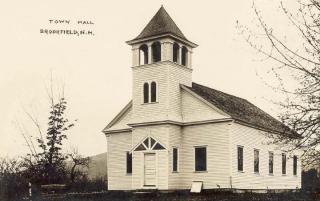A Brief History

Brookfield began as part of Middleton, NH, which was granted by the Masonian proprietors on April 27, 1749, to Ebenezer Varney and others. The Charter was renewed on March 21, 1770, and Middleton was incorporated on March 4th, 1778. The inhabitants of the north or second division of Middleton attempted to incorporate as a separate township in 1785 without success.
Finally, by act of the legislature, the town of Brookfield was incorporated on 30 December, 1794. In 1840, Brookfield became part of Carroll County, and Middleton stayed part of Strafford County. The county and town boundary lines, following the same co-ordinates, zig-zag through the Moose Mountains, separating the two towns.
The settlement of the area in the late 1700's was due in a great part to the building of the Governor John Wentworth Road from Portsmouth to his summer mansion on Lake Wentworth in Wolfeboro. Snaking through Rochester, Milton, Middleton and Wakefield into Brookfield, the route provided easy access to this undeveloped area by the mid 1760's. They came from Lee and Barrington, Newmarket and Portsmouth, Rochester and some of the border towns in Maine. They came to make a new life for themselves and their families.
Without the benefit of carriages or wagons, families with names like Chamberlain, Wiggin, Lyford, Hutchins, Burley, Hanson and Robinson made their way to what was then wilderness, and established settlements initially along the Governor’s Road. By the 1780's, settlements had spread along the northern side of the Moose Mountain range and up Tumbledown Dick, a mountain named for Oliver Cromwell’s ill-fated son. The road past Tumbledown Dick was the main road to Wolfeboro and Woodman Hill Road connected Brookfield to New Durham on the west. The mountain area, which offers several dependable sources of water, and back then, the advantage of being less marshy and choked with vegetation, was initially most conducive to building. Similarly, the high ground in the north of Brookfield – Stoneham Road and Tibbetts Hill - also became fast growing communities.
The heavily forested landmass yielded marginal land for grazing, with steep and numerous hills, and the soil plagued with boulders. The many miles of stonewalls, bordering the town’s roads and running through forestland, remind us of a time when the land was laid open as fields and pastures.
For most of the nineteenth century, the complexion of the town reflected most other agriculturally based economies throughout northern New England. Small farms provided the sustenance for the resident families, with additional crops to be bartered with the town’s craftsmen for the various needs of the residents. Early Brookfield was home to grist, bobbin, cider and shingle mills, several saw-mills, tanneries, cobbler and shoemaker shops, blacksmiths, inns and stores.
Gone are Brookfield’s Post Office, taverns and eight one-room schoolhouses. The historic Town House, built in the 1820s, is listed in the National Register of Public Buildings, and continues to be used for the annual Town Meeting and other community functions. In 2000, the town built a small town office building where the proceedings of the daily governmental process take place. Police, Fire and Sanitation services are purchased annually from the adjoining town of Wakefield. Schooling is provided through the Governor Wentworth Regional School system, with Brookfield students attending all grades in Wolfeboro. Shopping needs are met in Wolfeboro, Wakefield, and Rochester to the south.
In the first forty years of Brookfield’s existence as a community (1780-1820), the number of residents peaked at 690 residents in the 1820 census. The population then steadily dropped to an all time low in the mid-20th century. In the last forty years, there has been another boom, and with the end of the first decade of the 21st century, it appears that the population will be once again number close to 700 residents.
Brookfield has long been a residential, rural community, resistant to the commercial development that has affected so many New Hampshire towns. It will long continue to be an agreeable hometown for a modest number of people of modest means, moderate politics, and middling disposition.
Craig F. Evans, Archivist
Carolyn Chase, Town Historian

